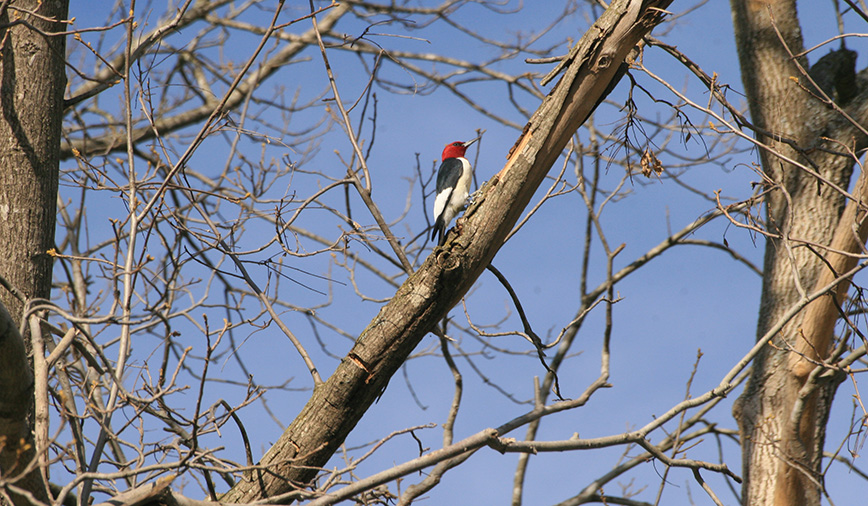What’s black and white and red all over, in nature? Here in the TriCities’ corner of the natural world, not a lot. But the red-headed woodpecker is one notable exception.
In our area, four woodpeckers are commonly seen: the tiny downy; its larger cousin the hairy; the red-bellied; and the northern flicker. Springtime brings brief sightings of yellow-bellied sapsuckers as they migrate north toward breeding grounds, and there are sporadic reports of the crow-sized pileated.
Then we have the red-headed child of the Picidae family. Although most male woodpeckers, and some females, have at least a splash of red on their heads, the red-headed woodpecker looks like it was dunked in a bucket of crimson dye. Picture Woody Woodpecker, take away the crest on his head, change his blue color to black and you’ll have a good idea of what this species looks like.
Its head and neck are completely red (unlike the misleadingly named red-bellied, whose broad streak of red on its head is far more noticeable than the namesake wash of red on its tummy). The rest of the redheaded’s body is boldly marked with big blocks of black and white—black on the back and tail, white on the chest, secondary wing feathers and rump.
They’re the sort of markings that birders consider “unmistakable”—which is good news for those of us who find mistakes easy to make when birding. But the somewhat more sobering news is that, even though the red-headed is instantly recognizable, few people here ever see them.
Although they’re not listed as threatened or endangered in Illinois, red-headed woodpeckers are a species in decline. Periodic fluctuations in population aren’t that unusual and in fact are a natural part of life on earth. But the red-headeds’ downward trend has held steady for more than 40 years. According to National Audubon Society statistics, red-headed numbers have dropped by 50% since 1966.
Our own Kane County Audubon statistics back up this trend. In 1972, the first year a Spring Bird Count was held here, birders counted 121 red-headed woodpeckers, the all-time high for this species. In 2007, the number was 3, an all-time low.
Earlier research indicated that competition with European starlings for cavity nesting sites was to blame. However, more recent studies show that starlings tend to nest earlier than red-heads, so perhaps their role has been exaggerated. Another issue of perhaps greater importance is habitat destruction, including the removal of dead trees.
It’s true that by our human standards, dead trees have little or no value. If they’re not too decayed they might be used for firewood, but mostly they’re simply cut down and hauled away, lest they become safety hazards.
But in natural areas, dead trees become Taj Mahals for countless numbers of critters large and small. While insects and other decomposers are munching away on the inside, recycling the tree’s components back into rich, nourishing soil, excavators like woodpeckers are pounding away on the outside. The cavities they create are start out as homes for themselves, but once they’ve moved on, any number of other creatures both feathered and furred may move in.
The next time you’re out for a walk and you pass by what looks like “just an old dead tree,” give it another look. Chances are good you’ll find evidence of woodpecker activity. Keep you eyes open—there just may be a red-headed nearby.
Pam Otto is the manager of nature programs and interpretive services for the St. Charles Park District. She can be reached at potto@stcparks.org or 630-513-4346.

